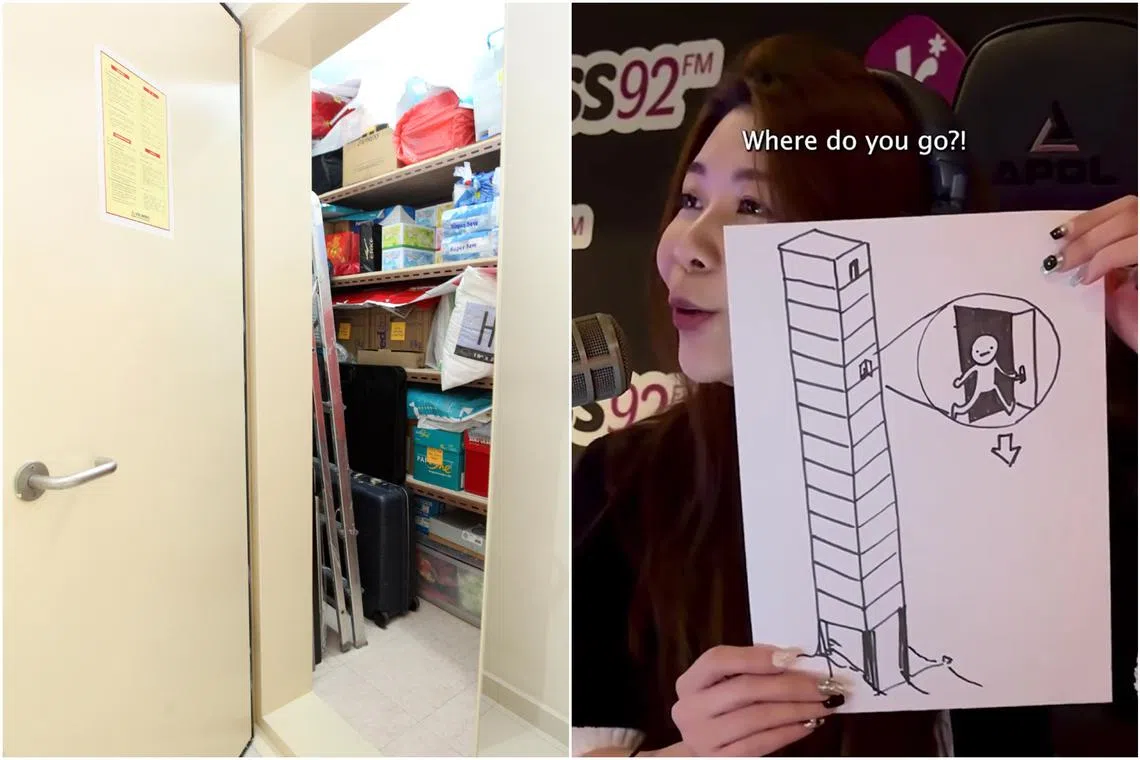How do household bomb shelters in Singapore really work?
Sign up now: Get ST's newsletters delivered to your inbox

A recent chat between deejays sparked the question: What happens to household shelters after a bomb attack?
PHOTOS: ST FILE, KISS92/INSTAGRAM
Follow topic:
- Singapore's household shelters, mandated since 1997, spark debate after radio hosts questioned their functionality post-bombing, highlighting concerns about building collapse.
- SCDF and architects clarify shelters protect from blast effects via reinforced structures; Nexus assures complete building collapse is "unlikely", addressing public concerns.
- Architects face challenges integrating shelters functionally during peacetime while adhering to strict regulations. Public shelters offer an alternative if residents are not home.
AI generated
SINGAPORE –The humble household shelter: In some homes, it is the “maid’s room”. In others, it is where junk goes to die. And in still others, it represents a loss of square footage to a space that cannot be structurally altered.
Nevertheless, if Singapore is ever under attack from aerial ordnance, many residents will have easy access to a household bomb shelter. But what happens after the hypothetical bombs have stopped?
The question came up during an on-air conversation between Kiss92 deejays Joshua Simon and Juliana Yeow in early July.
Yeow, referring to how shelters in HDB flats are built in a continuous vertical stack, asked where one goes once it is safe to leave the shelter.
“You just fall right through, right?” Simon pondered.
It is an issue that has got many in Singapore talking – the Kiss92 video has hit about 800,000 views on Instagram. It was also the topic of at least one debate on the r/singaporehappenings community on Reddit.
The idea of the household shelter is unique to Singapore, where the Civil Defence Shelter Act has mandated the inclusion of either a household shelter, or a storey shelter, in residential buildings since 1997.
Household shelters are located within residential units, while storey shelters are positioned in the common area on each floor – often an enclosed exit staircase in many private developments.
These shelters are designed to withstand blast and fragmentation effects, a spokesperson for the Singapore Civil Defence Force (SCDF) tells The Straits Times.
“In household and storey shelters, the protection to the occupants comes from a combination of thickened structures and the shielding offered by the surrounding walls, floor and ceiling slabs.”
As for the question raised by Yeow and Simon, the spokesperson would say only that the stacking of the shelters in vertical columns “enhances the overall strength and resilience of buildings against blast effects”.
The implication is that household shelters protect occupants from bombs – and not necessarily anything else.
Meanwhile, Mr Harvey Lukman, an associate director at DP Architects, says this is a question of engineering rather than architecture.
But he does add: “It is worth noting that SCDF and the Building and Construction Authority have stipulated the requirement for a strengthened ceiling slab directly above the household shelter’s door.
“This enhances protection for occupants as they enter or exit the shelter – whether to check on the situation outside or be rescued – in scenarios where the surrounding structure may be compromised.”
Meanwhile, a write-up about shelters on the SG101 portal – which is maintained by Nexus, the agency under the Ministry of Defence that oversees national education and total defence efforts – has a more straightforward answer: “It is unlikely that the entire block of flats will collapse in a bombing, leaving only a column of shelters standing.”
For now, the vertical stacking of household shelters is a bigger problem for architects such as Mr Lukman than it is for everyday Singaporeans. “Its position cannot vary within the same stack,” he says.
Another challenge: Placing the household shelters in such a way that they can be functional during peacetime, while also keeping to the shielding and setback requirements laid out in the Civil Defence Shelter Act.
“The household shelter is usually located near the entrance of the unit or in the kitchen/utility area, where it can serve a more functional purpose during peacetime. Placing it within bedrooms is generally avoided, as there are restrictions that limit internal and external modification of shelter walls,” says Mr Lukman.
Arguably, the storey shelter might be the more advantageous option in the unlikely catastrophe of a building completely collapsing but leaving the shelter stacks still standing. If nothing else, one can just take the stairs down.
The storey shelters also offer greater flexibility, particularly for smaller units, adds Mr Lukman. “They help to reduce structural complications, especially in cases where the residential tower sits above a commercial space or a carpark podium, or is situated above a basement.”
But the storey shelters are largely limited to private residential developments, as “the unit layouts of modern public housing today always include a household shelter in all unit types”, says Mr Daniel Po, associate director at DP Architects.
All of this may be moot if you are not home during the hypothetical bombing. But worry not: There are more than 500 civil defence public shelters in Singapore, including in some community centres, MRT stations and schools.
Although these may not be the answers they were looking for, Yeow and Simon say the debate has been a helpful reminder of the important role that shelters play in Singapore’s safety and total defence.
“I can’t believe this has been a question that has been bugging so many fellow Singaporeans,” says Yeow.
“Seeing everyone come together to speculate, and even think up hilarious solutions, is the kampung spirit that I live for,” says Simon.
“I feel pretty comforted that my shelter would really shield me from a bomb attack,” adds Yeow. “Now, I’m just counting on our buildings to hold up.”


